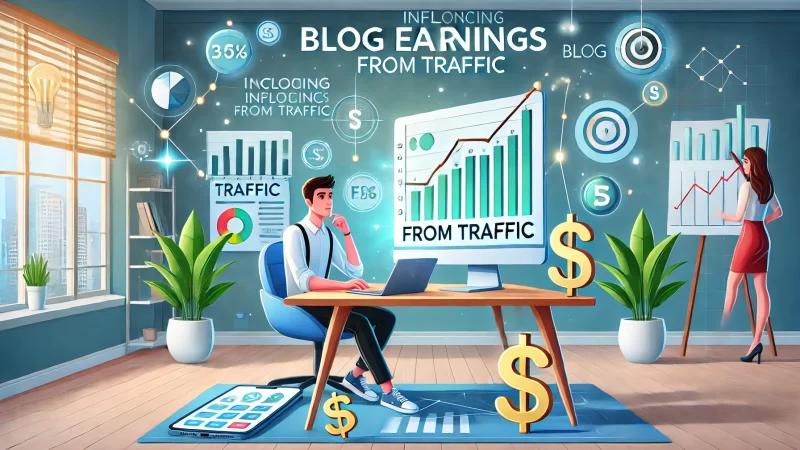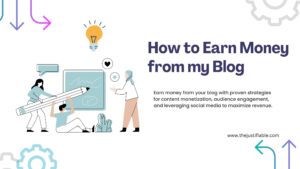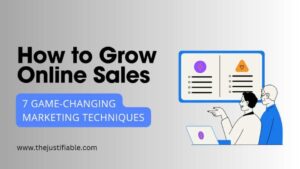Table of Contents
Ever wondered how many views for a blog to make money? Whether you’re starting out or scaling up, understanding blog traffic and its revenue potential is essential.
This guide explores what it takes to turn traffic into earnings and reveals the actionable strategies to maximize your blog’s profitability.
Understanding Blog Views And Revenue Potential
Understanding how blog views translate into revenue is crucial for any blogger aiming to monetize their platform. It’s not just about attracting visitors but knowing how to convert their engagement into income streams effectively and sustainably.
Analyzing The Relationship Between Traffic And Income
Traffic is the lifeblood of blog monetization, but not all traffic is created equal. I believe understanding this relationship starts with identifying how views align with your revenue goals. Higher traffic often boosts income, but only when paired with the right monetization strategy.
Each visitor offers a chance to generate revenue, whether through clicks on ads, purchases, or affiliate links. But low-quality traffic, such as uninterested or accidental clicks, rarely contributes to meaningful earnings. I recommend prioritizing genuine engagement over sheer numbers.
Blogs with high engagement rates often outperform those with higher traffic but lower interaction. For example, niche blogs with loyal followers may earn more than broad-interest blogs with sporadic visits. Balancing these aspects can maximize revenue potential.
Consistency also plays a role. Regular traffic ensures stable income, enabling you to plan for growth. This stability builds trust with advertisers and creates opportunities for diversifying revenue streams, from sponsorships to product launches.
Lastly, don’t overlook scalability. If your blog has a solid traffic base, you can focus on expanding your reach through strategies like SEO, social media, or collaborations. With more views, earning potential increases exponentially.
Common Monetization Models And Their Traffic Requirements
Choosing the right monetization model depends on your blog’s niche, audience, and traffic volume. Some methods require minimal traffic, while others demand significant numbers to be worthwhile. I suggest evaluating your options carefully to find the best fit.
Display ads, for instance, typically require thousands of views per month to generate noticeable revenue. Ad networks like Adsterra are beginner-friendly but have lower payouts unless you achieve high traffic consistently.
Affiliate marketing works well even with modest traffic if your audience is highly engaged. Bloggers in niches like tech, health, or finance often thrive in this model because their readers are likely to make purchases based on trusted recommendations.
Sponsored content often requires a substantial following to attract brands. Companies want to invest in bloggers who can showcase their products to a large, engaged audience. Creating a compelling media kit can help you secure these opportunities.
Selling your products or services offers flexibility. Whether you have a course, e-book, or physical product, this model allows you to monetize without relying heavily on external platforms. Even a small but loyal audience can bring significant revenue here.
Why Traffic Quality Matters More Than Quantity
Not all blog traffic is equal in value. I’ve seen firsthand how quality traffic can drive better results than high volumes of uninterested visitors. Focusing on the right audience ensures higher engagement, which translates into higher revenue.
Targeting specific demographics helps filter out uninterested visitors. For instance, if your blog covers vegan recipes, attracting health-conscious readers who might also buy cookbooks or meal plans is far more valuable than random clicks.
Bounce rate—how quickly visitors leave your blog—is another important metric. A high bounce rate often indicates low-quality traffic. I recommend optimizing your content to keep readers engaged and reduce this metric.
Search engine optimization (SEO) plays a huge role in driving quality traffic. Well-researched keywords and compelling headlines attract readers genuinely interested in your content. These readers are more likely to interact with ads, buy products, or share posts.
Building relationships with your audience is key. Engaged readers return, trust your recommendations, and contribute to sustained income. Creating meaningful content helps you attract the right people, turning every view into a potential source of revenue.
Factors Influencing Blog Earnings From Traffic

Several factors influence how much money a blog can make from its traffic. I recommend considering the niche, audience behavior, and monetization methods you choose to maximize your blog’s profitability.
Exploring Niches With High Revenue Potential
The niche you choose can significantly impact your earning potential. Certain topics, like finance, technology, or personal development, often attract higher-paying opportunities due to their broader appeal and higher ad rates.
High-revenue niches usually have products or services with substantial profit margins. For instance, a blog about software reviews can earn more from affiliate sales than a general lifestyle blog with minimal product opportunities.
Niche popularity matters too. Highly competitive niches like fitness may require a strong strategy to stand out, while smaller niches often have loyal audiences willing to spend on premium content or services.
I suggest researching the profitability of your niche before committing fully. Check ad rates, affiliate programs, and market demand to gauge how much traffic you’ll need to succeed financially.
Consistency in content creation also drives success. The more frequently you publish relevant, high-quality content, the better your chances of maintaining and growing an engaged audience within your niche.
The Role Of Audience Demographics In Monetization
Knowing your audience’s demographics is vital for effective monetization. I recommend gathering data about their age, location, income level, and interests to tailor your blog’s content and advertising approach.
High-income audiences often have a greater purchasing power, making them more likely to buy premium products or services you recommend. For instance, tech-savvy readers may invest in expensive gadgets based on your reviews.
Understanding your readers’ pain points also helps. Blogs that solve specific problems or answer targeted questions often build trust, which translates into higher conversion rates for affiliate links or product sales.
Geographical location influences ad revenue. Advertisers pay more for audiences from countries like the U.S., U.K., or Canada due to higher purchasing power. Targeting these regions can significantly boost your earnings.
Engaging with your audience through surveys or comment sections can provide insights into their preferences. This information allows you to refine your content strategy and offer products or services they truly value.
Importance Of Conversion Rates In Generating Revenue
Conversion rates measure how effectively your blog turns visitors into paying customers. I believe this is one of the most critical factors in blog monetization, as even high traffic means little without conversions.
Focus on crafting compelling calls to action (CTAs). Whether it’s encouraging readers to click an affiliate link, sign up for a course, or buy a product, clear and persuasive CTAs make a significant difference.
Test different monetization strategies to see what resonates with your audience. Some blogs perform better with affiliate links, while others thrive on selling exclusive content or services. Experimentation is key to finding your ideal approach.
I suggest optimizing user experience to improve conversions. Fast-loading pages, mobile-friendly designs, and intuitive navigation keep readers engaged and encourage them to take desired actions.
Tracking metrics like click-through rates and sales data is essential. Analyzing this information helps you understand what’s working and where you need to adjust, ensuring steady improvements in revenue over time.
How Many Views Are Needed For Ad Revenue?
Generating ad revenue depends on the number of impressions your blog receives, combined with factors like ad placement and audience engagement. Understanding these elements helps you set realistic traffic goals to earn through advertising networks.
Breaking Down Revenue Per Thousand Impressions (RPM)
RPM (Revenue Per Thousand Impressions) is a standard metric that determines how much you earn per thousand ad views. I believe it’s a key concept for any blogger relying on ads for income.
The average RPM can range from $2 to $10 depending on your niche, audience demographics, and advertiser competition. For example, tech blogs often see higher RPMs than general lifestyle blogs because advertisers value those readers more.
Your audience’s geographic location also impacts RPM. Advertisers pay more for impressions in countries with higher purchasing power. For instance, U.S.-based traffic typically generates higher RPMs than traffic from less developed markets.
Optimizing your content for ad placement increases RPM. Well-placed ads that don’t disrupt the reader’s experience tend to get more impressions and clicks, directly influencing your earnings.
Focus on building trust with your audience. Readers who feel connected to your blog are less likely to use ad-blockers, ensuring higher visibility for your ads and better RPM rates.
Average Traffic Requirements For Display Ads
For most blogs, ad revenue becomes meaningful at a traffic level of 10,000 monthly page views or higher. I recommend setting this as an initial milestone for those starting out with display ads.
Display ads through networks like Google AdSense provide steady income, but significant traffic is required to make them lucrative. Blogs with millions of views typically earn thousands of dollars, highlighting the importance of scalability.
High-traffic blogs often benefit from premium ad networks like Popads or Adsterra. These platforms have stricter traffic requirements, such as 50,000 or 100,000 monthly sessions, but offer better payouts than entry-level options.
Engagement matters just as much as numbers. Ads perform better on blogs where readers spend more time exploring multiple pages. I suggest creating content that encourages deeper engagement to boost overall revenue.
Balancing traffic growth with user experience is crucial. Too many ads can alienate your audience, leading to lower return visits. Focus on strategic placements and valuable content to achieve sustainable growth.
Maximizing Ad Revenue With Engaging Content
Engaging content is a game-changer for ad revenue. I’ve noticed that blogs with compelling content see higher click-through rates (CTR), which directly boosts ad earnings.
Start by creating content that resonates with your audience. Topics they find useful or enjoyable keep them on your page longer, increasing the chances of ad impressions and interactions.
I recommend experimenting with ad formats. Video ads, for instance, often outperform static banners in terms of engagement. Test different formats to see what works best for your blog.
High-quality visuals paired with ads enhance user experience. If your blog looks professional and visually appealing, readers are more likely to trust the ads displayed alongside your content.
Track performance regularly. Analyzing metrics like CTR, impressions, and revenue helps you identify what’s working and refine your strategy. Consistent adjustments keep your ad revenue growing.
Views Required To Earn Through Affiliate Marketing

Affiliate marketing requires less traffic than ad revenue but emphasizes quality over quantity. Focusing on building trust with your audience ensures your recommendations lead to meaningful conversions and consistent earnings.
Identifying Profitable Affiliate Programs
Choosing the right affiliate programs is crucial for success. I suggest starting with well-established programs that align with your niche, as they often offer better commissions and resources for beginners.
High-commission products like software or online courses can generate significant income even with modest traffic. Look for programs offering payouts of 20% or higher to maximize your earnings.
Subscription-based products are great for recurring income. Recommending services like web hosting or streaming platforms ensures a steady revenue stream as long as users stay subscribed.
Focus on programs that provide marketing support. Some affiliates offer banners, email templates, and training materials, making it easier to promote their products effectively on your blog.
How Traffic Affects Affiliate Conversion Rates
Traffic quality plays a massive role in affiliate marketing success. I’ve seen how a smaller but engaged audience often outperforms a larger, disengaged one in terms of conversions.
Your audience’s intent matters. Readers searching for “best kitchen gadgets” are more likely to buy an affiliate product than those casually browsing lifestyle blogs. Tailor your content to match their needs.
Including detailed product reviews increases trust and conversion rates. People value honest, in-depth recommendations, so focus on providing genuine insights about the products you promote.
Affiliate banners rarely convert as well as contextual links. Embedding links naturally into your content ensures they feel like part of the story rather than a hard sell.
Practical Tips For Driving More Affiliate Revenue
Growing affiliate revenue requires a combination of traffic strategies and content optimization. I recommend starting with SEO, as it attracts readers actively looking for the solutions you offer.
Collaborating with influencers or guest bloggers can introduce your blog to new audiences. These partnerships often lead to increased traffic and exposure for your affiliate links.
Create lead magnets like free e-books or checklists. These tools help you build an email list, which is invaluable for nurturing relationships and promoting affiliate products.
Don’t be afraid to experiment. Test different products, link placements, and call-to-action phrasing to see what drives the most conversions. Flexibility is key to long-term success.
Traffic Needs For Sponsored Content Opportunities
Sponsored content offers bloggers a lucrative way to monetize their platforms, but it’s essential to meet sponsors’ expectations. Sponsors typically look for blogs with a substantial, engaged audience, making traffic quality just as important as traffic volume.
Minimum Traffic Expectations Of Sponsors
Sponsors usually require a baseline level of traffic to consider a blog for partnerships. I’ve seen that reaching 5,000 to 10,000 monthly page views is often the starting point for smaller brands, while larger companies expect significantly higher numbers.
Engagement is equally critical. Even if you have moderate traffic, high interaction rates (like comments and shares) signal an active audience, making your blog more appealing to sponsors. Focus on building a community, not just growing numbers.
Niche relevance influences traffic expectations. Blogs in specific niches like health or finance may attract sponsors even with lower traffic because their audiences are highly targeted and valuable to brands in those industries.
Maintaining consistency in traffic matters. Sponsors prefer reliable performance over sporadic spikes in visits. Regular posting schedules and steady growth reassure them that their investment will reach a stable and engaged readership.
Highlight your unique selling points, such as demographic data or reader loyalty. Sponsors value insights into your audience, so showcase what makes your blog an excellent platform for their message.
Crafting A Media Kit That Attracts Brands
A professional media kit is your blog’s resume, showing sponsors why they should work with you. I suggest including traffic stats, audience demographics, and examples of previous partnerships to highlight your value.
Keep your media kit visually appealing. Use clean layouts, brand colors, and engaging imagery to make it stand out. First impressions count, and a polished presentation can make a lasting impact.
Include clear metrics, like average monthly page views and social media followers. This data gives sponsors a snapshot of your reach and helps them assess whether your blog aligns with their goals.
I recommend showcasing testimonials or case studies from past collaborations. Positive feedback demonstrates reliability and builds trust, making sponsors more confident in their decision to partner with you.
Offer tiered pricing options in your media kit. Different sponsorship packages, such as a blog post, social media promotion, or a combination, cater to varying budgets and increase your chances of closing deals.
Strategies To Secure High-Paying Sponsorship Deals
- Securing high-paying sponsorship deals requires a proactive approach. I believe reaching out to brands directly is often more effective than waiting for opportunities to come your way.
- Research brands that align with your niche and values. Approaching companies that already resonate with your audience ensures better results and a more authentic partnership.
- Personalized pitches work wonders. I advise tailoring your outreach emails to highlight how your blog can help sponsors achieve their goals, making your proposal hard to ignore.
- Focus on long-term partnerships. Sponsors appreciate bloggers who can consistently deliver value. Building lasting relationships not only secures repeat deals but also creates steady income streams.
- Continuously improve your blog’s value proposition. Whether it’s enhancing your design, boosting traffic, or increasing engagement, these efforts make your platform more attractive to sponsors over time.
Selling Products Or Services With Blog Traffic

Using your blog traffic to sell products or services can provide a direct revenue stream. I suggest leveraging your expertise to offer items that align with your niche and address your audience’s specific needs.
Setting Realistic Goals For Product Sales Revenue
Setting realistic sales goals helps you track progress and refine strategies. I recommend starting with a revenue target based on your audience size and average product price to establish achievable benchmarks.
Estimate your conversion rates. If 2% of your audience purchases a $50 product, you can calculate how many views or visitors are needed to reach your revenue target. This clarity keeps your efforts focused.
Consider testing pricing strategies. Offering introductory discounts or bundles can boost initial sales and build momentum. Keep experimenting until you find what resonates with your audience.
Track key performance indicators (KPIs) like sales volume and customer feedback. These metrics help you understand what’s working and where improvements are needed to meet your revenue goals.
Leveraging Traffic To Build Trust And Authority
Trust is essential for convincing readers to buy from you. I suggest creating informative content that showcases your expertise, making your audience more likely to invest in your products or services.
Customer testimonials add credibility. Share positive reviews from satisfied buyers to build confidence in your offerings and encourage hesitant readers to make a purchase.
Consistency in messaging matters. Whether you’re promoting a product or service, ensure your marketing aligns with your blog’s tone and values. This alignment strengthens trust and fosters loyalty.
Use social proof strategically. Highlight milestones, such as “500+ happy customers,” to demonstrate your product’s popularity and reliability, further convincing potential buyers.
Tips For Promoting Your Products Effectively
Effective promotion starts with clear communication. I advise crafting compelling product descriptions that emphasize benefits, not just features, to show readers why they need your product.
Incorporate visuals like photos or videos. Seeing your product in action makes it more relatable and helps potential customers visualize how it fits into their lives.
Email marketing remains a powerful tool. Sending personalized recommendations or special offers to your subscribers creates a sense of exclusivity and urgency, driving more sales.
Collaborate with influencers or affiliates to expand reach. Partnering with trusted voices in your niche exposes your product to new audiences and boosts credibility.
Calculating Break-Even Traffic Goals For Bloggers
Understanding your break-even point is critical to building a profitable blog. This calculation helps you determine the minimum traffic needed to cover expenses and start generating income.
Identifying Your Blog’s Operating Expenses
To calculate break-even traffic, you first need to identify your costs. These might include web hosting, marketing tools, content creation, and other overheads. I suggest keeping a detailed record of these expenses.
Don’t forget to account for hidden costs, like freelance support or software subscriptions. Including these ensures you have a complete picture of your financial obligations.
Separate fixed and variable costs. Fixed costs remain the same each month, while variable costs fluctuate based on factors like traffic growth. This separation helps you plan more effectively.
Once you know your total monthly expenses, divide them by your average revenue per visitor to estimate how much traffic you need to break even. This simple formula guides your growth goals.
Setting Traffic Benchmarks To Cover Costs
Setting benchmarks gives you clear targets to aim for. For example, if your blog’s expenses are $500 monthly and you earn $0.05 per page view, you’ll need at least 10,000 views to break even.
Regularly revisit your benchmarks. As your expenses or revenue per visitor change, adjust your traffic goals to reflect these updates and maintain profitability.
Focus on monetizing effectively. Increasing your revenue per visitor through strategies like affiliate marketing or premium content helps you reach break-even faster, even with modest traffic.
Building scalable systems, like evergreen content or automated email campaigns, ensures sustained traffic and revenue growth without proportionally increasing costs.
Scaling From Break-Even To Profitable Traffic Levels
Scaling beyond break-even requires optimizing both traffic and monetization. I believe diversifying income streams is key to turning a profitable blog into a thriving business.
Invest in SEO to attract more organic traffic. High-quality content targeting the right keywords increases your visibility and brings consistent, engaged visitors to your site.
Experiment with new revenue opportunities. Consider adding courses, e-books, or memberships to expand your offerings and cater to different audience needs.
Reinvest profits into your blog. Whether it’s upgrading tools, hiring help, or improving content quality, these investments pay off by boosting both traffic and earnings over time.
Tools And Metrics To Track Blog Traffic

Tracking blog traffic effectively helps you make informed decisions to improve performance and revenue. I recommend using tools and metrics that provide actionable insights into your audience’s behavior, preferences, and engagement patterns.
Using Google Analytics To Monitor Performance
Google Analytics is an essential tool for tracking blog traffic. It offers detailed reports on page views, user demographics, and engagement metrics. I believe its user-friendly interface makes it a must-have for any blogger.
Understanding where your traffic comes from, such as search engines or social media, helps you refine your marketing strategies. Focus on high-performing sources to drive even more visitors to your blog.
Bounce rates reveal how long users stay on your site. A high bounce rate suggests your content isn’t meeting expectations. Use this data to improve pages with low retention and keep readers engaged.
Conversion tracking in Google Analytics is invaluable for measuring success. Whether it’s sign-ups, purchases, or clicks, tracking these actions lets you assess how well your blog monetization efforts are working.
Set up goals in Google Analytics. For example, tracking how many visitors navigate from a blog post to a product page can guide future optimizations. Goals align your traffic with specific revenue objectives.
Insights From Heatmaps And User Behavior Tools
Heatmaps provide visual data on user activity, showing which parts of your blog attract the most attention. I recommend using tools like Hotjar or Crazy Egg to complement analytics data.
Heatmaps reveal click patterns, helping you place CTAs and ads more effectively. For example, positioning affiliate links in high-traffic areas increases the likelihood of conversions.
User behavior tools also show how far visitors scroll on a page. If they’re not reaching key sections, I suggest revisiting your layout to ensure important information isn’t missed.
Session recordings let you watch how users interact with your blog in real-time. This feature highlights usability issues and helps you create a smoother, more intuitive experience for your readers.
Feedback surveys integrated into these tools provide qualitative insights. Asking readers what they enjoy or struggle with helps you tailor your content and improve user satisfaction.
Tracking ROI From Different Monetization Strategies
Tracking return on investment (ROI) ensures you’re getting value from your monetization strategies. I suggest using metrics like revenue per user and cost per acquisition to evaluate performance.
Calculate the earnings from display ads or affiliate links relative to the traffic they generate. This data clarifies whether your chosen methods are worth the effort or need adjustment.
For sponsored posts, compare income against the time spent creating and promoting the content. If the ROI is low, renegotiating terms or focusing on higher-paying opportunities could be beneficial.
Measure email marketing ROI by analyzing open and click-through rates. These metrics show how effectively your campaigns convert traffic into paying customers.
Use tools like SEMrush or Ahrefs to assess the value of your SEO efforts. Track the ranking of targeted keywords and their contribution to overall traffic and revenue.
Strategies To Increase Blog Traffic Quickly
Increasing blog traffic quickly requires a mix of proven techniques and consistent effort. I recommend prioritizing strategies that not only boost visits but also attract the right audience for your content.
Optimizing For SEO To Attract More Readers
SEO optimization is one of the most effective ways to drive organic traffic. Targeting the right keywords ensures your blog appears in searches relevant to your niche.
Start with thorough keyword research using tools like SEOPowersuite. Choose terms with a balance of search volume and competition to maximize visibility.
Write engaging meta descriptions for your posts. These short summaries entice readers to click, improving your blog’s click-through rate and overall traffic.
Optimize images by compressing files and adding alt text. Faster-loading pages and accessible content contribute to better SEO rankings and a smoother user experience.
Update older posts with fresh information and optimized keywords. This practice boosts their chances of ranking higher in search results, bringing in more traffic over time.
Leveraging Social Media To Drive Engagement
Social media platforms are powerful tools for promoting blog content. I suggest tailoring your approach to each platform’s unique audience and features.
Share visually appealing graphics or short videos to capture attention. Content that stands out is more likely to be shared, expanding your blog’s reach organically.
Engage with your audience through comments and direct messages. Building relationships fosters loyalty and encourages followers to visit your blog regularly.
Utilize trending hashtags to increase visibility. Including popular but relevant tags in your posts exposes your content to a wider audience interested in your niche.
Post consistently to stay top of mind. Regular updates keep your followers engaged and more likely to click through to your latest blog posts.
Collaborating With Other Bloggers For Mutual Growth
Collaborating with other bloggers can introduce your content to new audiences. I recommend partnering with creators in similar niches for the best results.
Guest posting is an excellent way to reach a larger audience. Writing for another blog gives you exposure while providing value to their readers.
Hosting joint webinars or live events creates opportunities to engage with both audiences at once. This strategy fosters community while increasing visibility for everyone involved.
Cross-promote each other’s content on social media. Sharing posts, linking back to your blogs, or tagging collaborators can significantly boost traffic for all parties.
Networking at industry events builds relationships that lead to future collaborations. Genuine connections often result in long-term partnerships that benefit both your blog and theirs.
Common Mistakes That Limit Blog Revenue Potential

Avoiding common mistakes is critical for maximizing your blog’s revenue. I believe identifying and addressing these pitfalls early can save time and help you focus on strategies that work.
Ignoring Traffic Quality Over Quantity
Focusing solely on increasing traffic without considering quality can harm your blog’s revenue potential. A smaller but engaged audience is far more valuable than thousands of uninterested visitors.
Low-quality traffic rarely converts into meaningful actions like purchases or clicks. Prioritize attracting readers genuinely interested in your niche for better monetization results.
Audience targeting tools, like Facebook ads, help refine your strategy. Reaching the right people ensures your efforts translate into actual revenue rather than wasted visits.
Monitor metrics like time on page and bounce rate. These indicators reveal how engaged your readers are, giving you insights into improving traffic quality.
Underestimating The Importance Of Call-To-Actions
A lack of clear CTAs often results in missed opportunities. I suggest incorporating compelling prompts throughout your content to guide readers toward desired actions.
Effective CTAs use action-oriented language. Phrases like “Discover More” or “Shop Now” encourage clicks and drive conversions. Test different wording to find what resonates.
Place CTAs strategically, such as at the end of posts or within high-traffic sections. Visible and relevant prompts ensure readers know what steps to take next.
Use urgency sparingly but effectively. Limited-time offers or exclusive deals tied to your CTAs can motivate readers to act immediately, boosting results.
Choosing The Wrong Monetization Model For Your Niche
Not all monetization methods work for every blog. I recommend evaluating your niche and audience before committing to specific strategies to avoid wasted effort.
Blogs in niches with high affiliate potential, like tech or finance, thrive on commissions. Conversely, lifestyle blogs often perform better with sponsored posts or product sales.
Test multiple revenue streams to find what works best. Experimenting with different options ensures you’re maximizing your blog’s earning potential.
Regularly reassess your approach. As your blog grows, switching or expanding monetization methods might be necessary to match evolving traffic and audience needs.






